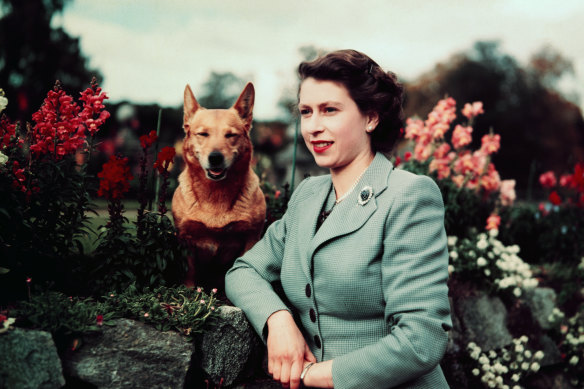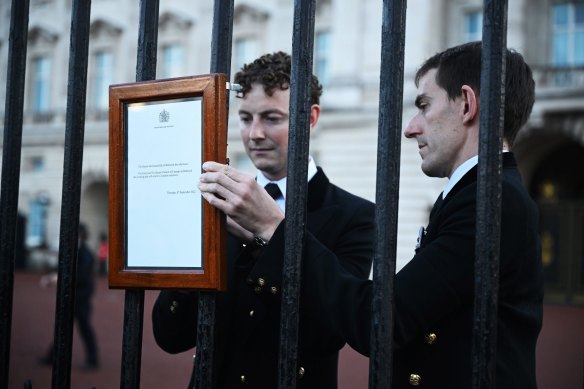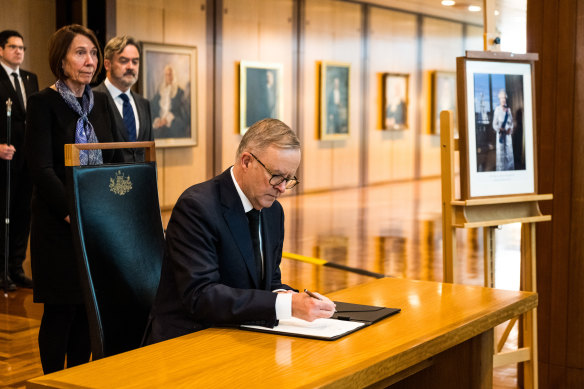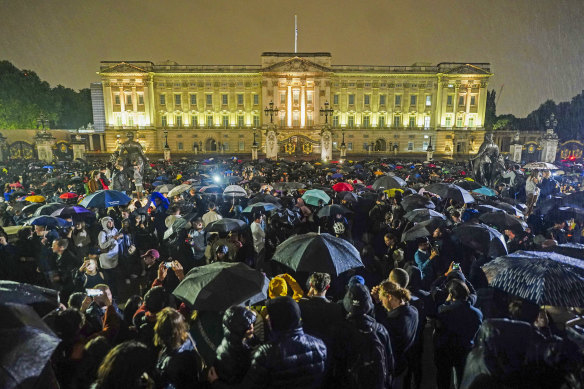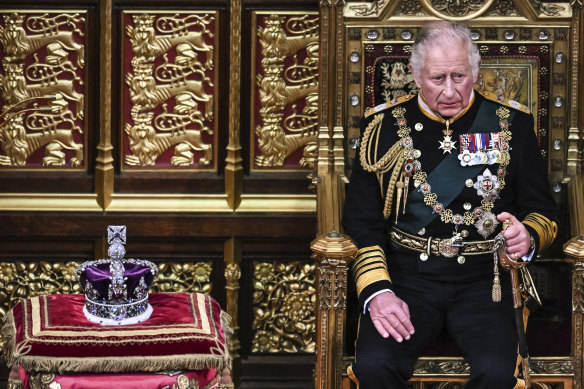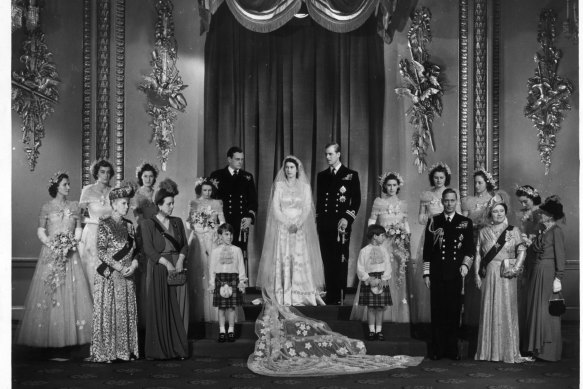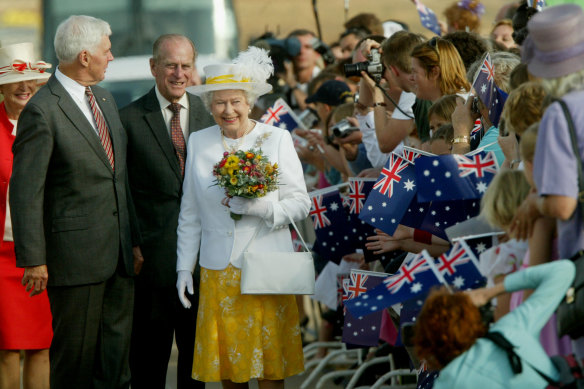To palace staff, the date of the Queen’s death is known as “D-Day”, and the carefully planned Operation London Bridge has now swung into action.
Aninety-six gun salute over Canberra. Lights off on the Eiffel Tower in Paris. And tears and flowers at the gates of Buckingham Palace in England.
This is how countries around the world are marking the passing of Queen Elizabeth II, Britain’s longest-serving monarch. Since she took the throne at age 25 in 1952, the Queen has become a beloved symbol of stability in the post-world-war era. To some, perhaps, it seemed as if her reign would never end. But the formalities of her death have been methodically planned for years (and now updated for the coronavirus pandemic).
When Buckingham Palace announced that the Queen had passed away peacefully at her Balmoral estate in the Scottish Highlands on the afternoon of September 8 (3.30am September 9 AEST), Operation London Bridge swung into action. To palace staff, the date of the Queen’s death is known as “D-Day” and each day following, leading up to the funeral, is referred to as D+1, D+2 and so on. Here’s what we know so far about what happens.
Queen Elizabeth II of England at Balmoral Castle with one of her corgis, in 1952, the year she became Queen.Credit:Getty
Day One, “D-Day”
Operation London Bridge began with a phone call. New Prime Minister Liz Truss was one of the last people to see the Queen in person, when she was sworn into office just two days earlier, and she was the first to be officially notified of Her Majesty’s death at 4.30pm. The Queen’s private secretary would have called on a secure line to say “London Bridge is down”, meaning the Queen is dead, and her son Charles is king.
A footman emerged from Buckingham Palace to pin the Official Notification of the Queen’s death to the gates, as parliaments were suspended in the UK and in Commonwealth nations across the globe, and flags dropped to half-mast. It’s part of formal mourning periods across the 14 other nations where the Queen is head of state (and 39 other countries in the Commonwealth).
The “D-Day” plans have long allowed for the chance the Queen would die at Balmoral, one of her favourite places and her primary residence since the pandemic hit. Leaked excerpts of Operation Unicorn, this Scottish leg of the plan, indicate her coffin will temporarily rest at the Palace of Holyroodhouse in Scotland before being conveyed to London.
The official statement confirming the death of the Queen is attached to the gates of Buckingham Palace.Credit:Leon Neal/Getty
When night falls in Canberra on D-Day, a special gun salute will fire one cannon round for every year of the Queen’s life. Federal parliament won’t return until after her funeral.
In the coming days, Prime Minister Anthony Albanese and Governor-General David Hurley will travel to London to meet with the Commonwealth’s new sovereign, King Charles III. Albanese, who has said the Queen’s loss will be felt deeply, had not yet visited the UK and had an audience with the Queen since becoming prime minister in May.
A national memorial service will be held in Australia for the Queen after his return from London, as part of a fortnight of official mourning.
UK embassies around the world have laid out condolence books – US President Joe Biden visited his own in Washington to add his name. (She “was more than a monarch, she defined an era,” he said of Queen Elizabeth.) Australia’s parliament and Government Houses in each state too have laid out condolence books, and the Governor-General’s website has an online book for signing. National monuments will light up in Britain’s Union Jack colours around the globe over the coming nights, including Sydney’s Opera House.
Australian Prime Minister Anthony Albanese signs the Queen’s book of condolences at Parliament House, Canberra.Credit:James Brickwood
Day Two, “D+1”
King Charles III is expected to address the nation the day after the Queen’s passing and his accession to the throne (although his official coronation ceremony may not be for some months).
As the Queen died late in the day on Thursday UK time, some plans have been shifted back. The new King had dashed to her bedside in Scotland. But he will return to London and speak at 6pm local time (3am Saturday AEST). He will also meet the prime minister and her cabinet, as well as the Earl Marshal – the Duke of Norfolk – who is in charge of the Queen’s funeral. Church bells will toll across the country, and royal salutes will be fired.
People gather outside Buckingham Palace following the death of Queen Elizabeth.Credit:AP
Meanwhile, members of the Accession Council (made up of senior government figures and members of the Privy Council) will meet at St James Palace to proclaim Charles the new sovereign. High commissioners of the realms, including from Australia, will be invited as observers.
Charles is expected to then hold his first Privy Council, accompanied by the Queen Consort Camilla and Prince William (who are also privy counsellors), and make his personal declaration and oath. The first public proclamation of the new sovereign will be read out, and the government will swear their allegiance.
In Australia, there are plans Saturday for the governor-general, the prime minister and opposition leader Peter Dutton to lay wreaths for the Queen at Parliament House, joined by federal ministers, MPs and senators.
Charles, then Prince, sits by the Imperial State Crown in the House of Lords during the opening of Parliament this year, the first time the Queen had missed the event in six decades.Credit:AP
Day Three
If Operation Unicorn unfolds to plan, the Queen’s coffin will likely be taken from Balmoral to the nearby city of Aberdeen and then to the Palace of Holyroodhouse in Edinburgh, by the Royal Train. (Mourners are expected to line the tracks.)
Meanwhile, at 11am Sunday AEST, Albanese will lead a meeting of ministers to consider the proclamation of the new King, with all ministers invited to attend. That will trigger a formal recommendation to the governor-general to issue the proclamation in Australia, which the governor-general is expected to read at noon this Sunday at Parliament House – a public event marked by a 21-gun salute.
Day Four
The King is expected to deliver a speech to parliament in Westminster on Monday. There, MPs will likely pass a motion of condolence and give more tributes, though all other parliamentary business will stay on hold.
The Queen’s coffin will travel up “the royal mile” to St Giles cathedral in the middle of Edinburgh, where the King will attend a service later that day. It will kick off a national tour to mark the Queen’s death, including remembrance services in Belfast and Cardiff, as part of Operation Spring Tide that co-ordinates the King’s accession.
Queen Elizabeth, then Princess with Prince Philip, in the Throne Room of Buckingham Palace after their wedding in 1947.
Day Five
The Queen’s coffin is expected to arrive in London, where it will be installed in the Throne Room at Buckingham Palace. Rehearsals will begin for its procession to the Palace of Westminster.
Day Six
The Queen’s lying in state will begin in Westminster Hall, known as Operation Marquee. Her coffin is to arrive in a ceremonial military procession, on a gun carriage, with the royal family walking behind. Hundreds of thousands of people will file past the coffin over the next four days to pay their respects, as they did for the Queen Mother’s lying in state in 2002 and for King George VI in 1952. Her coffin will lie on a raised box known as a catafalque, with a wreath of flowers and the Imperial State Crown on top.
Day Seven
Throughout the public lying-in state, senior royals are expected to pay their own tribute by standing guard over the coffin in a tradition known as the Vigil of the Princes.
Day Eight
As rehearsals continue for the Queen’s funeral, world leaders and other prominent figures will begin to arrive in the UK.
Days Nine and 10
The Queen’s funeral is expected to happen within nine or 10 days of her death, at Westminster Abbey. The morning of the funeral will see the Queen’s body moved from Westminster Hall to Westminster Abbey, and a moment of national silence will fall across the country as the world watches the official farewell. The London Stock Exchange will close.
That same day, there will also be a service of committal and a private interment service. The Queen’s body will be laid to rest in King George Chapel, buried alongside her mother and father and the ashes of her sister.
According to royal plans, a smaller family service will be held within 12 days of her death at Windsor Castle.
And finally, the body of Prince Philip, the Duke of Edinburgh and her husband of more than 70 years, will be transferred from the Royal Vault to rest with the Queen.
The Queen and Prince Philip during their tour of Australia in 2006 to open the Commonwealth Games.Credit:Chris Lane
Receive a wrap of our coverage as the world mourns Queen Elizabeth II in our Morning Edition newsletter. Sign up here.
If you'd like some expert background on an issue or a news event, drop us a line at [email protected] or [email protected]. Read more explainers here.
Most Viewed in World
Source: Read Full Article
